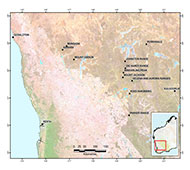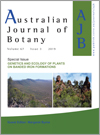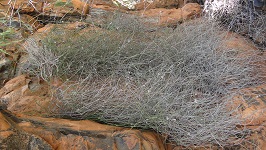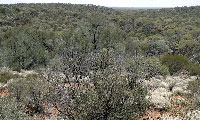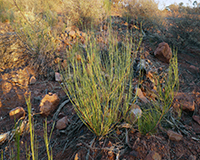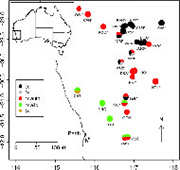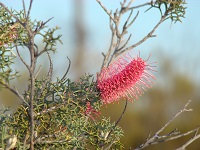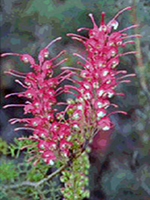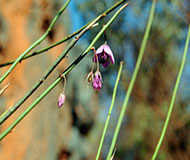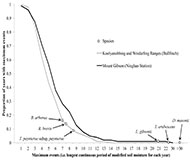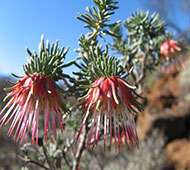Australian Journal of Botany
Volume 67
Number 3 2019
Genetics and Ecology of Plants on Banded Iron Formations
Genetic and ecological studies have been undertaken on several species that are endemic to, or have distributions centred on, the banded iron formations of the Yilgarn, providing a basis for understanding the diversity and evolutionary history of the plant communities that occur in these diverse environments. This Special Issue brings together studies on several these species to complement studies already published, and this overview provides a summary of the genetics and ecology of 21 species that are restricted to, or have distributions centred on, BIFs.
Proposed impacts on rare species affect not only population size, but also genetic diversity and its spatial structure, a loss of which can increase extinction risk. We assessed genetic variation and its spatial structuring in Tetratheca erubescens, a species restricted to a single 2-km-long ironstone range. Impact from the loss of plants within a proposed mine footprint on the genetic variation assessed with these markers was found to be negligible.
Proposed impacts on rare species affect not only population size, but also genetic diversity and its spatial structure, a loss of which can increase extinction risk. We assessed genetic variation and spatial structuring in Ricinocarpos brevis, a species restricted to three Banded Ironstone Ranges in the Yilgarn region of Western Australia. Impact from the loss of plants within a proposed mine footprint on the genetic variation assessed with these markers was found to be negligible.
We used genetic analyses of Acacia karina, a Banded Iron Formation (BIF) associated species, to better understand historical processes in the semiarid midwest region of Western Australia. Similarly high levels of genetic diversity were observed in BIF and non-BIF populations. The genetic data suggest that BIFs have not acted as climate refugia for A. karina. Instead, long-term persistence of BIF and non-BIF populations is supported.
Genome multiplication (polyploidy) is an important phenomenon in plant evolution. We studied genetic patterns in a group of rare sedges (the Lepidosperma costale species complex) that grow on rocky outcrops in south-west Western Australia. Diploid populations maintained higher genetic diversity than polyploid populations, which were more likely to contain hybrids and reproduce asexually.
Establishing sustainable populations that maximise potential for long-term viability is a key component of successful restoration activities. We present a model based approach that uses detailed spatial, genetic, demographic, and life history data to assess the impact of different numbers, spatial positioning, and genetic compositions of founder individuals on measures of population growth and genetic diversity in restored populations over time. The method can be applied to simulate the outcome of particular restoration establishment scenarios for species with differing patterns of genetic structure and differing life history traits.
We constructed ecological niche models for eighteen conservation-significant plant species from Banded Ironstone Formation (BIF) ranges, centred on the Helena and Aurora Ranges in semiarid south-western Australia. We tested whether non-occurrence in neighbouring ranges was due to habitat dissimilarity and found that models gave expected results for the non-BIF associated species and the generalist. The other 16 species were all predicted to occur on all neighbouring BIFs suggesting habitat suitability is not range restrictive.
Pollination biology of arid zone plant species is poorly understood, but is vital for population maintenance. Some species that occur on economically important sites in the arid zone are being threatened by mining activities, so understanding their reproductive biology is important for devising conservation strategies. The pollination biology of four Tetratheca species that grow on Banded Iron Formations that are subject to iron ore mining was examined to assess its importance in population survival.
Seedlings must germinate and establish during favourable conditions to ensure the survival of plant populations. Seedling establishment in water-limited environments is a significant challenge and we suggest that it occurs on an irregular basis through a strategy of bet-hedging. Knowledge of what conditions initiate seedling establishment and when this is likely to occur in the environment supports the development of better conservation management actions.
Several dozen rare plant species associated with Banded Iron Formation hills in Western Australia are potentially threatened by mining activity. We studied the patterns of growth, reproduction, survival and seedling recruitment for two such species, finding that they are apparently slow growing and long lived with infrequent reproduction, and recruitment that mostly follows fire, which likely occur at multi-decadal frequencies. Understanding these patterns should assist when planning future developments that impact these and similar species, and also their conservation and management.
